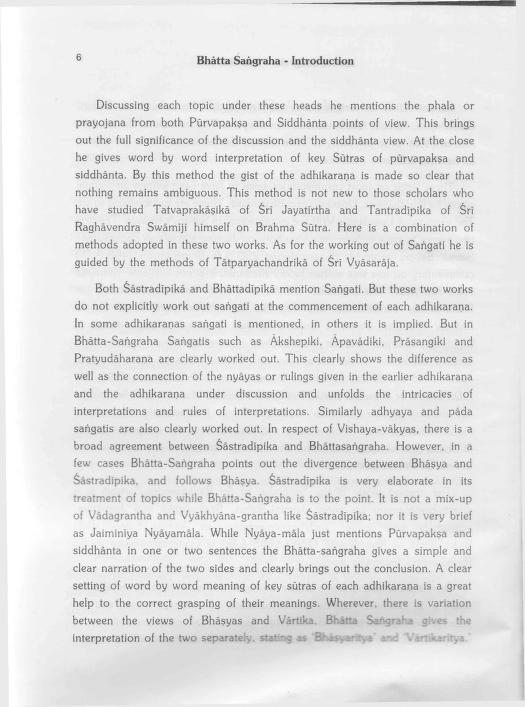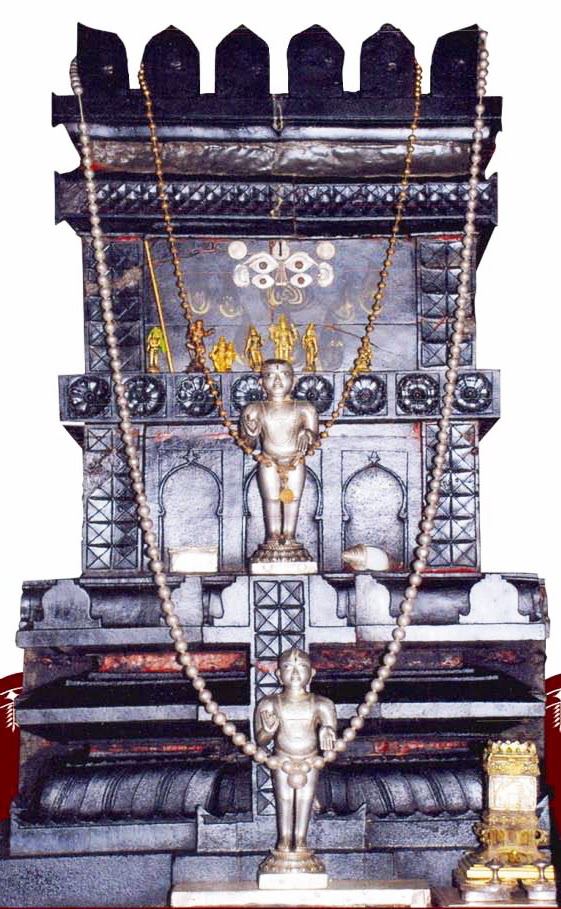[SRI RAGHAVENDRA GURUSARVABHAUMA : GRANTHA PARICHAYA]
GITA PRASTHANA -
1. Geetartha Sangraha:
More popularly known as Geeta-Vivrutti, a lucid original commentary on the gita
2. Gitabhashya Prameyadipika Bhavadipa:
Commentary on Srimadacharya's Geeta Bhashya (1/n)
GITA PRASTHANA -
1. Geetartha Sangraha:
More popularly known as Geeta-Vivrutti, a lucid original commentary on the gita
2. Gitabhashya Prameyadipika Bhavadipa:
Commentary on Srimadacharya's Geeta Bhashya (1/n)

3. Gitabhashya Nyayadipika Bhavadipa:
A commentary on Madhvacharya’s Geeta Tatparya.
4. Geeta Tatparya Teeka Vivarana:
Tippani on Jaya Muni's commentary on Acharya Madhva’s Geeta Tatparya (2/n)
A commentary on Madhvacharya’s Geeta Tatparya.
4. Geeta Tatparya Teeka Vivarana:
Tippani on Jaya Muni's commentary on Acharya Madhva’s Geeta Tatparya (2/n)

UPANISHAD PRASTHANA-
Upanishad Khandarthas:
Khandarthas (Word by word meaning)
Lucid expositions on 9 out of 10 Upanishads commented upon by Madhvacharya (except aitareya Upanishad). He wrote a gloss on only the mantra part of the Upanishad – Aitareya Mantraartha Sangraha (3/n)

Upanishad Khandarthas:
Khandarthas (Word by word meaning)
Lucid expositions on 9 out of 10 Upanishads commented upon by Madhvacharya (except aitareya Upanishad). He wrote a gloss on only the mantra part of the Upanishad – Aitareya Mantraartha Sangraha (3/n)


SHRUTI PRASTHANA-
1.Veda Traya Vivruti:
Commentaries on all three vedas
2. Mantrartha Manjari:
A commentary on the first 3 Adhyayas (40 Suktas) of the Rig Veda, the same ones covered by Srimadacharya in the Rig Bhasya (4/n)

1.Veda Traya Vivruti:
Commentaries on all three vedas
2. Mantrartha Manjari:
A commentary on the first 3 Adhyayas (40 Suktas) of the Rig Veda, the same ones covered by Srimadacharya in the Rig Bhasya (4/n)


3. Sookta Vyakhyana:
Commentaries (short glosses) Purusha sookta, Sri sookta, Balittha sookta, Ambhrani sookta and few unavailable works (probably on Manyu, Hiranyagarbha, Samudra, Pavamana etc) . (5/n)

Commentaries (short glosses) Purusha sookta, Sri sookta, Balittha sookta, Ambhrani sookta and few unavailable works (probably on Manyu, Hiranyagarbha, Samudra, Pavamana etc) . (5/n)


SUTRA PRASTHANA -
1. Anubhashya Tattva Manjari:
A detailed exposition of the Anubhashya of Srimadacharya
2. Tattvaprakashika Bhavadipa:
Clinical exposition on Tatvaprakashika (Jaya Muni's commentary on the Brahma Sutra Bhashya of Srimadacharya) (6/n)



1. Anubhashya Tattva Manjari:
A detailed exposition of the Anubhashya of Srimadacharya
2. Tattvaprakashika Bhavadipa:
Clinical exposition on Tatvaprakashika (Jaya Muni's commentary on the Brahma Sutra Bhashya of Srimadacharya) (6/n)




3. Nyaya Sudha Parimala:
Most renowned elucidation on Nyayasudha of Jaya Muni. Rayaru is hence Parimalacharya.
4. Chandrika Prakasha:
Commentary on the Tatparya Chandrika of Vyasa Muni
5. Nyaya Muktavali:
Brief exposition of the Adhikaraashariras of the Brahmasutras (7/n)

Most renowned elucidation on Nyayasudha of Jaya Muni. Rayaru is hence Parimalacharya.
4. Chandrika Prakasha:
Commentary on the Tatparya Chandrika of Vyasa Muni
5. Nyaya Muktavali:
Brief exposition of the Adhikaraashariras of the Brahmasutras (7/n)


6. Tantra Dipika:
Aptly named for the – term “Tantra” means “Religious Treatise – Scientific Treatise – Composition of Divine Authority” and Deepika means beacon. It elucidates, limelights and mirrors with utmost clarity, all the essentials of each Brahmasutra. (8/n)



Aptly named for the – term “Tantra” means “Religious Treatise – Scientific Treatise – Composition of Divine Authority” and Deepika means beacon. It elucidates, limelights and mirrors with utmost clarity, all the essentials of each Brahmasutra. (8/n)




OTHER TIPPANIS -
1. Dasha Prakarana Tippani :
Glosses on 6/10 Prakaranas (Tattvasankhyana, Tattvaviveka, Tattvodyota, Vishnutattva Nirnaya, Karmanirnaya, Pramana Lakshana) of Srimadacharya, omitting the four Mandaramanjaris already commented upon by Vyasa Muni. (9/n)

1. Dasha Prakarana Tippani :
Glosses on 6/10 Prakaranas (Tattvasankhyana, Tattvaviveka, Tattvodyota, Vishnutattva Nirnaya, Karmanirnaya, Pramana Lakshana) of Srimadacharya, omitting the four Mandaramanjaris already commented upon by Vyasa Muni. (9/n)


2. Vadavali Bhavadipa :
Commentary on Vadavali of Jaya Muni
3. Pramana Padhati Tippani Bhavadipa:
Elucidation of Pramana padhdhati of Jaya Muni
4. Tarkatandava Vyakhyana (Nyayadipika) :
Elaborate and clinical exposition on Tarkatandava of Vyasa Muni (10/n)


Commentary on Vadavali of Jaya Muni
3. Pramana Padhati Tippani Bhavadipa:
Elucidation of Pramana padhdhati of Jaya Muni
4. Tarkatandava Vyakhyana (Nyayadipika) :
Elaborate and clinical exposition on Tarkatandava of Vyasa Muni (10/n)



INDEPENDENT WORKS -
A) CHARITRA MANJARIS :
1. Rama Chartirya Manjari:
A short work highlighting the major aspects of Rama Avatara.
2. Krishna Charitrya Manjari:
A brief work capturing the bountiful essence of Krishna Avatara. (11/n)



A) CHARITRA MANJARIS :
1. Rama Chartirya Manjari:
A short work highlighting the major aspects of Rama Avatara.
2. Krishna Charitrya Manjari:
A brief work capturing the bountiful essence of Krishna Avatara. (11/n)




B) GADYAS :
1. Pratah Sankalpa Gadya:
A prose to recited in the morning as a resolution to perform the day’s activities.
2. Sarva Samarpana Gadya:
A prose recited in the night to submit the day’s activities to the Lord. Goes along with Pratah Sankalpa Gadya. (12/n)

1. Pratah Sankalpa Gadya:
A prose to recited in the morning as a resolution to perform the day’s activities.
2. Sarva Samarpana Gadya:
A prose recited in the night to submit the day’s activities to the Lord. Goes along with Pratah Sankalpa Gadya. (12/n)


C) STOTRAS :
1. Nadi Taratamya stotra:
Captures sanctity of the holy rivers of Bharat with hierarchical classification.
2. Rajagopala Stotra:
Brief stotra extolling Mannaru Sri Rajagopalaswamy.
3.Dashavatara Stuti:
A short work capturing the opulence of the dashavataras (13/n)



1. Nadi Taratamya stotra:
Captures sanctity of the holy rivers of Bharat with hierarchical classification.
2. Rajagopala Stotra:
Brief stotra extolling Mannaru Sri Rajagopalaswamy.
3.Dashavatara Stuti:
A short work capturing the opulence of the dashavataras (13/n)




D) VYAKARANA / MIMAMSA :
1. Bhatta Sangraha:
A Commentary on the Mimamsa Sutras of Jaimini following the Bhatta SCHOOL. Rare work of a Tattvavada Acharya on other systems of thought. (14/n)



1. Bhatta Sangraha:
A Commentary on the Mimamsa Sutras of Jaimini following the Bhatta SCHOOL. Rare work of a Tattvavada Acharya on other systems of thought. (14/n)




E) BHAVA SANGRAHA / VYAKHYANA:
1. Mahabharata Tatparya Nirnaya Bhava Sangraha:
A short summary of Tatparya Nirnaya by Srimadacharya (essence of each Adhyaya captured in one verse) .
2. Anu Madhva Vijaya Vyakhyana:
Commentary on the AMV of Sri Narayana Panditacharya (15/n)



1. Mahabharata Tatparya Nirnaya Bhava Sangraha:
A short summary of Tatparya Nirnaya by Srimadacharya (essence of each Adhyaya captured in one verse) .
2. Anu Madhva Vijaya Vyakhyana:
Commentary on the AMV of Sri Narayana Panditacharya (15/n)




KANNADA KRITIS/SULADIS:
1. Indu Enage Govinda :
Most renowned kriti of Rayaru capturing the leelas of Bhagavan through padasmarana of Udupi Sri Krishna. (16/n)

1. Indu Enage Govinda :
Most renowned kriti of Rayaru capturing the leelas of Bhagavan through padasmarana of Udupi Sri Krishna. (16/n)


Gururayaru has blessed us with a plethora of works, each profound in meaning, writing and intent. Gururayaru has provided a helping hand for the sadhakas to cross the ocean of samsara through his granthas & this is why he is renowned as KALIYUGADA KALPATARU & KAMADHENU (17/n) 



The vyapti and depth of Gururayaru's works across the Sastras, Vedanta & Tattvavada is in itself a miracle. May Gururayaru, who has touched every aspect of the philosophical literary tradition through the light of the Munitrayas works, bless us.
SRI GURURAJO VIJAYATE🙏🚩 (18/18)


SRI GURURAJO VIJAYATE🙏🚩 (18/18)



• • •
Missing some Tweet in this thread? You can try to
force a refresh






